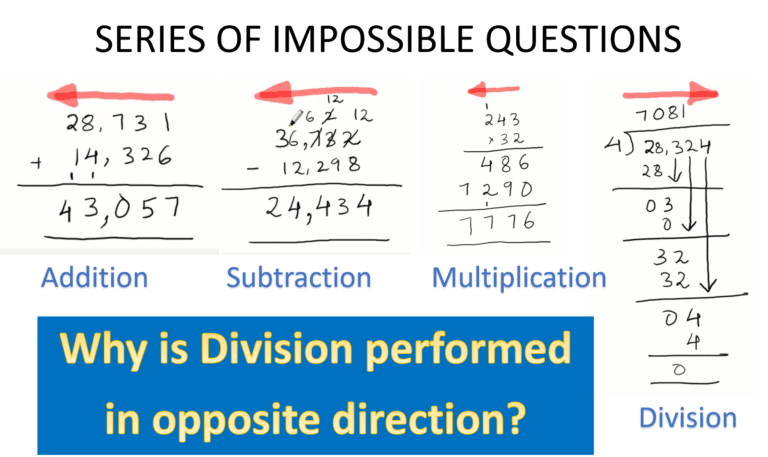How to Tackle Difficult Math Questions?
When we do addition, subtraction, or multiplication, we start on the right and work our way to the left. That example, you would start by adding the right-most integers with the lowest place values and then work your way left until the problem is solved. But have you ever observed that we do the reverse with division?
Logic dictates that multiplication and division are similar, so they should share similar patterns, attributes, and processes. Or if we apply another skewed logic, we should say that subtraction and division are destructive and decreasing in nature and so they should share a similar pattern. But why does only division stand out as an anomaly from the rest of the crowd and why not any other operation? Let's find out.
Get Your FREE Math Worksheets Now!
Overcoming difficult Math problems
For those of you who get dizzy looking at this much text, you can jump to the YouTube video: Click Here
For a question about the fundamentals of mathematics, we need to look at the fundamentals of the number system. The number system that we follow depends on place values. A simplified explanation of place values can be given with candy. Let us assume that the ones place which can be assumed as loose candy. And tens place can be assumed as a group of ten candies. And the hundreds place can be assumed as the pack of hundred candies and so on. So now, let's start the operations.
Let's imagine we're adding two numbers: 27 and 48. Let's go the wrong way around. Let's start with the tenth spot. We have two groups of 10 chocolates in the first number and four in the second number, for a total of six groups. Now, we'll add to the lower place value. The first number contains seven loose candies, while the second has eight. When we add them together, we get 15 candies. But we know we can select out ten candies and form a new group. So, we have to redo the ten-place addition.
Don’t you think it would have been convenient to start with one place and work your way up as the groups keep on piling? Hence, we add from the lowest place value to the highest place value. The same goes for subtraction and the same goes for multiplication.
Let's use the same technique to division and do it the opposite way around to check if the operation still works. Let's pretend we're dividing 54 by 3. We understand that dividing means distributing among individuals. Let us begin with the one's place. We have four candies and need to split them among three persons. We give one candy to each child, leaving one as the leftover. Now we'll move on to the tens. We split the five groups of 10 sweets so that each youngster receives one group of ten candy.
Now, we have 2 groups of ten candy left. We have to break this group into loose candies and add the one remaining candy to make 21 loose candies. Now, we can divide it into 7 candies for each child. It feels better to go according to the convention and first divide the larger pool and break down the remaining into the smaller pool. Hence, the division has to go in the opposite direction.
In conclusion, if we go the wrong way around in these operations of addition, subtraction, multiplication, and division, we end up doing the process multiple times. This makes the process lengthy. Hence, we follow the standard direction and convention to make our life easier.
Book a free trial class with us today if you want to learn the best and easiest ways to solve these hard math questions free trial class with us today!
FAQs (Frequently Asked Questions)
Q1. What are the best strategies to follow to tackle tricky math problems?
A. You can break down the problem into smaller steps, identify the key concepts involved, and use visualization techniques like drawing diagrams or graphs.
Q2. How to I improve problem-solving speed for difficult math questions?
A. Problem-solving speed gradually improves with regular practice, familiarity with problem types, and honing mental math skills.
Q3. Why are some math problems more difficult than others?
A. It is because of unfamiliar formats, multiple steps, or the combination of concepts. Building a strong foundation fundamentals will help in better understanding and solving the problem.
Q4. How to stay motivated when facing frustrating math problems?
A. Taking breaks and revisiting problems with a fresh mind can help reduce frustration. Surround yourself with a supportive study environment.

 Students/Staff
Students/Staff Parents
Parents ElevatEd
ElevatEd














